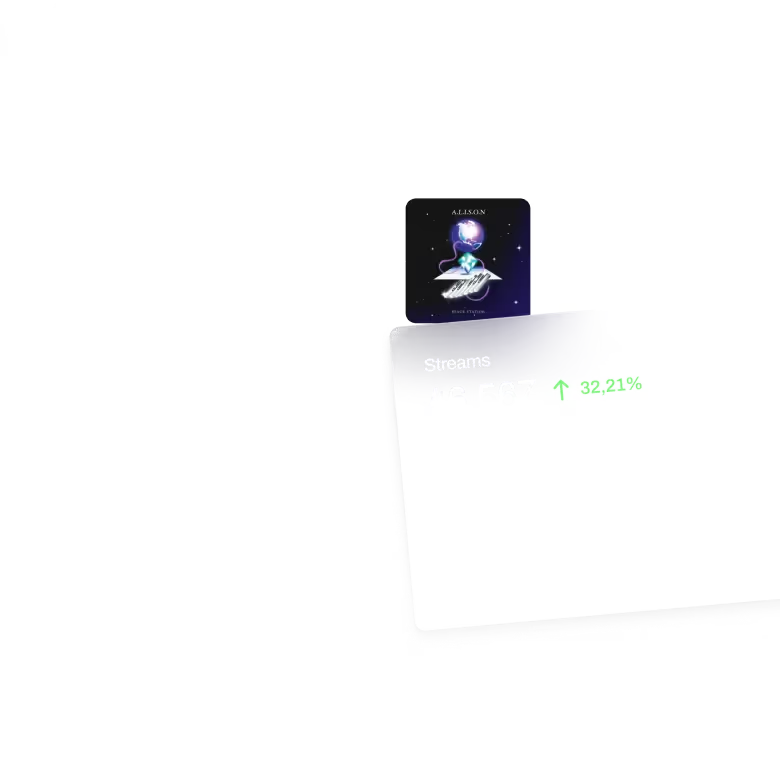
7 Best Music Streaming Services For Artists in 2025

It feels like a new streaming service pops up every single day.
As of March 2025, we distribute to 84 music streaming platforms – and that number grows regularly.
So with that much choice out there, how can you know which music streaming service is best for you? What’s the best music streaming service for listeners? What’s the best music streaming service for artists? What’s the most popular music streaming service?
Those are all really great questions – keep reading to find out the answers!
Spotify: the most popular music streaming service

Spotify Pros
✅ Huge user base
✅ Personalised new music discovery
✅ Best artist promotional features
Spotify Cons
❌ No high-res audio (yet)
❌ Relatively low streaming earnings
Of the 7 music streaming services we’re comparing here, Spotify has more monthly active listeners than the rest combined – so yeah, Spotify’s kind of a big deal.
It’s the platform you probably think of first when you hear ‘music streaming’, and it’s the platform most people have at least tried using at some point in their lives.
But is it the best music streaming service?
It’s definitely the most popular – which, as an artist, means it has the biggest audience ready-and-waiting to discover your music. Spotify also leads the pack in terms of discoverability, with a strong personalised algorithm and the ability for artists to opt tracks into Discovery Mode for even greater reach.
Spotify is arguably the most innovative platform, in the sense that most other music streaming platforms follow-suit with Spotify’s features. It supports music videos, has a free (ad-funded) plan, and has probably the most comprehensive suite of promotional tools for artists too (including Spotify’s Campaign Kit).
For most average listeners of music, Spotify is a great choice of streaming platform.
For most artists, releasing music on Spotify is a must, simply because of its huge user base.
Spotify Factsheet
🎧 Listeners: 675 million
🔎 Music Discoverability: ⭐⭐⭐⭐⭐
📚 Library Size: 100 million+
💰 Streaming Revenues: 💲💲
🆓 Free to Listen? ✅
🎥 Music Videos Supported? ✅
📈 Artist Promotion Features? ✅
Apple Music: the best for Apple users

Apple Music Pros
✅ Lossless & spatial audio supported
✅ Integrates with downloaded music
✅ Great for Apple OS
Apple Music Cons
❌ Less new music discoverability
❌ Only ideal for Apple users
❌ Limited artist promotion features
Apple Music might only have less than a sixth of the users Spotify has, but it’s still worth considering as a top contender in the battle for best music streaming service – particularly if you’re already bought into the Apple ecosystem.
With support for lossless and spatial audio, music videos and the option to seamlessly integrate downloaded music into your Apple Music app, it’s got the basics and more covered.
However, as you’d expect from a music streaming service that’s basically an add-on to Apple’s core products, it lacks innovation in some areas.
New music discoverability is not as good as Spotify’s, although certainly better than some of the smaller platforms in this guide, and Apple Music’s support for artists running promotional campaigns on their music is less sophisticated and extensive than Spotify’s.
For listeners who already use iPhones, iPads, AirPods and any other Apple product, Apple Music is a great option that will seamlessly sync across devices.
For artists, releasing music on Apple Music is worthwhile for higher audio quality and the ability to reach die-hard Apple fans.
Apple Music Factsheet
🎧 Listeners: 93 million
🔎 Music Discoverability: ⭐⭐⭐⭐
📚 Library Size: 100 million+
💰 Streaming Revenues: 💲💲💲💲
🆓 Free to Listen? ❌
🎥 Music Videos Supported? ✅
📈 Artist Promotion Features? ✅
Amazon Music: the best for Amazon Prime subscribers
%201.svg)
Amazon Music Pros
✅ High-res audio supported
✅ Integrates with Alexa devices
✅ Great for Amazon Prime members
Amazon Music Cons
❌ No free tier
❌ No music videos
❌ Limited new music discoverability
Like Apple Music, Amazon Music caters to a particular subset of music listeners: those who already use Amazon and subscribe to Amazon Prime.
And, like Apple Music again, the fact that music streaming isn’t the core focus of Amazon’s digital services puts it immediately behind Spotify in terms of popularity, features and support for artists.
However, it’s not all doom and gloom. Amazon Music supports high-res audio, integrates well with Alexa-powered devices (‘Hey Alexa, play the best independent music released this week’) and hosts a huge library of music.
Its limited discoverability features and lack of music video support make it difficult to recommend Amazon Music as a just-as-good alternative to Spotify, but Amazon Music certainly has its place in the music streaming industry and isn’t going anywhere anytime soon.
For listeners who own Amazon devices, use Amazon regularly and subscribe to Amazon Prime, Amazon Music is likely the best music streaming service.
For artists, releasing music on Amazon Music is worthwhile, particularly if your fans prefer high-res audio.
Amazon Music Factsheet
🎧 Listeners: 80 million
🔎 Music Discoverability: ⭐⭐⭐
📚 Library Size: 100 million+
💰 Streaming Revenues: 💲💲💲💲
🆓 Free to Listen? ❌
🎥 Music Videos Supported? ❌
📈 Artist Promotion Features? ✅ (limited)
YouTube Music: the best for music videos

YouTube Music Pros
✅ Best search features
✅ Great for music videos
✅ Integrates with Google devices
YouTube Music Cons
❌ Poor new music discoverability
❌ Disappointing audio quality
❌ Compressed streams
Clearly, YouTube Music leads the pack when it comes to music videos – but does it stand up to scrutiny in other areas?
As the second-most popular music streaming service by quite a margin (Apple Music comes closest at 93 million, versus YouTube Music’s 125 million), clearly YouTube Music has something going for it.
YouTube Music is owned by Google, meaning that its search engine is second-to-none, its advertising features use Google’s well-established Ads platform, and it easily integrates with Google devices (‘Hey Google, play my favourite songs’). It boasts that it has ‘songs, covers, remixes, live performances, and content that is hard to find elsewhere’ – and that’s certainly true.
However, YouTube Music doesn’t perform quite as well in other areas.
The top-performing search function is balanced out by poor-performing discoverability. Without Spotify, Apple Music or Amazon Music’s curated and personalised playlists, YouTube Music definitely falls short.
And for listeners who want high-quality audio, YouTube Music shouldn’t be their first choice. YouTube Music compresses streams, losing quality in the process and delivering a less-than-ideal listening experience.
For listeners, YouTube Music is a great option if you’re keen to engage with your favourite artists through their music videos – but not so great if you care about audio quality.
For artists, releasing music on YouTube Music is definitely worthwhile if your focus includes creating music videos to engage fans on a deeper level.
YouTube Music Factsheet
🎧 Listeners: 125 million
🔎 Music Discoverability: ⭐⭐⭐
📚 Library Size: 100 million+
💰 Streaming Revenues: 💲💲💲
🆓 Free to Listen? ✅
🎥 Music Videos Supported? ✅
📈 Artist Promotion Features? ✅
Deezer: the best for community engagement

Deezer Pros
✅ Focus on community features
✅ Good value for money
✅ Good new music discoverability
Deezer Cons
❌ Little social media integration
❌ No high-res audio support
❌ Minimal user interface
The first of the sub-100 million users category, Deezer’s music streaming service is much less well-known than Spotify, Apple Music, Amazon Music or YouTube Music – but that doesn’t mean it’s not just as good in many areas.
Deezer’s one of the newer kids on the music streaming block but has maintained relevance in an increasingly competitive market. Deezer offers a free ad-supported tier, highly-followed editorial playlists and community features, like quizzes, that no other music streaming service (so far) offers.
While it doesn’t support high-res audio, Deezer’s sound quality is still decent (and definitely better than YouTube Music, for example). Deezer’s algorithmic discovery isn’t at Spotify’s level, with little in the way of predictive algorithms or personalised playlists, but their emphasis on curated editorial playlists makes discovering new music easy.
Deezer hasn’t invested heavily in social media integrations, meaning the wider fan engagement does feel somewhat lacking.
For listeners, Deezer is a great option if your focus is on decent sound quality, curated playlists and a minimal user interface.
For artists, releasing music on Deezer is definitely worthwhile considering the higher rate of revenue payouts, particularly if you’re able to land an editorial playlist placement for your music.
Deezer Factsheet
🎧 Listeners: 9.9 million
🔎 Music Discoverability: ⭐⭐⭐⭐⭐
📚 Library Size: 100 million+
💰 Streaming Revenues: 💲💲💲💲
🆓 Free to Listen? ✅
🎥 Music Videos Supported? ✅
📈 Artist Promotion Features? ✅
Tidal: the best for audiophiles

Tidal Pros
✅ Industry-leading audio quality
✅ Intuitive user interface
✅ Direct artist payouts
Tidal Cons
❌ Higher cost than other services
❌ Little social media integration
❌ Limited editorial playlists
Tidal takes music seriously. While its user base is far behind almost every other music streaming service (except for Qobuz), Tidal’s 3 million users are highly-engaged and are there for its industry-leading audio quality.
Tidal’s focus from the start has been delivering the highest quality audio to listeners. Which means that its other features are somewhat lacking.
There’s little to no social media integration and limited editorial playlists, although algorithmic discovery is decent, and users pay a relatively high cost to access a stripped-back music streaming interface.
For audiophiles, there’s no better music streaming service out there than Tidal. Accessible via iOS, Android and desktop, it doesn’t discriminate on technology preferences and can easily connect to almost any listening device.
For listeners, Tidal is the top pick if audio quality matters to you.
For artists, Tidal might not have the largest user base, but it does pitch itself as having artists’ needs front-and-centre – evidenced by its initiatives towards direct payments based on listener habits, rather than aggregated attribution.
Tidal Factsheet
🎧 Listeners: ~3 million
🔎 Music Discoverability: ⭐⭐⭐⭐
📚 Library Size: 100 million+
💰 Streaming Revenues: 💲💲💲💲💲
🆓 Free to Listen? ❌
🎥 Music Videos Supported? ✅
📈 Artist Promotion Features? ✅ (limited)
Qobuz: the best for high-res music streaming

Qobuz Pros
✅ Industry-leading audio quality
✅ High-res purchases supported
✅ Integrated with audio hardware
Qobuz Cons
❌ Small user base
❌ No music videos
❌ No artist promotion support
Qobuz is the smallest player in the music streaming big-league – but that doesn’t mean it’s not worth considering, both as a listener and an artist.
Qobuz’s goal is to be ‘the premier destination for high quality music’ – something they achieve by supporting high-res audio uploads and high-res purchases/downloads too. For listeners who want to actually own digital music of the highest quality, there’s no doubt Qobuz is the best option.
Catering to audiophiles goes as far as being built into a huge range of audio hardware too, including Samsung TVs, Apple CarPlay and Android Auto – and Qobuz is the only music streaming service to provide 24-bit/48kHz playback on Sonos devices.
However, the emphasis on high-quality audio means that Qobuz does lack development in other areas. Music videos aren’t supported, there are very limited opportunities for artists to promote their music on-platform, and Qobuz’s reach is extremely limited at only 200,000 users.
For listeners concerned with high-quality audio and the option to actually own music downloads, Qobuz is a great option.
For artists, releasing music on Qobuz won’t hugely extend your reach (due to Qobuz’s small user-base), but if your fans are invested in listening to high-quality audio it’s worthwhile having a presence on the music streaming service, particularly considering the higher per-stream payouts.
Qobuz Factsheet
🎧 Listeners: 200,000+
🔎 Music Discoverability: ⭐⭐⭐⭐
📚 Library Size: 100 million+
💰 Streaming Revenues: 💲💲💲💲💲
🆓 Free to Listen? ❌
🎥 Music Videos Supported? ❌
📈 Artist Promotion Features? ❌
Which music streaming service is the best for independent artists?
Clearly, with Spotify having a larger user base than every other streaming platform (in this guide, at least) combined, it’s a no-brainer for you as an artist to be releasing your music on Spotify.
It’s the most used platform, which means it has the most revenue to invest in innovation – hence why it leads the way with new features that enhance the Spotify experience for both artists and listeners. Its discoverability is second-to-none, which is incredibly important for independent artists growing their music careers.
However, that’s not to say being present on the other music streaming services isn’t worthwhile.
At the end of the day, the more streaming services you release your music on, the more users your music has the potential to reach – and the more streaming revenue you have the potential to generate.
The golden rule is to be where your audience is.
If you know for a fact that your audience primarily uses Apple Music for streaming, that’s probably going to be the platform you focus on primarily, while something like Tidal or Qobuz might be unnecessary for you.
Focus your efforts on the music streaming service that works best for you, by monitoring your streaming performance across platforms and taking into account the revenue you receive from each platform too.
Thankfully, Identity Music artists can release music on over 80 music streaming services – with no extra costs or hidden fees to release everywhere you physically can. Getting your music in front of potential fans is simple and easy!
Note: revenue per 1,000 streams is an estimate, based on data collated by Duetti’s 2024 Music Economics Report. Actual earning per 1,000 streams may vary.






